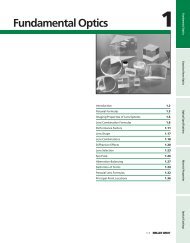Intel PXA250 and PXA210 Applications Processors
Intel PXA250 and PXA210 Applications Processors
Intel PXA250 and PXA210 Applications Processors
You also want an ePaper? Increase the reach of your titles
YUMPU automatically turns print PDFs into web optimized ePapers that Google loves.
System Memory Interface<br />
Table 2-6. BOOT_SEL Definitions (Sheet 2 of 2)<br />
BOOT_SEL<br />
2 1 0<br />
Boot From . . .<br />
1 0 1 1 16-bit Synchronous Mask ROM (64 Mbits)<br />
1 1 0 2 16-bit Synchronous Mask ROMs = 32-bits (64 Mbits each)<br />
1 1 1 1 16-bit Synchronous Mask ROM (64 Mbits)<br />
2.6.3 SRAM / ROM / Flash / Synchronous Fast Flash Memory<br />
Options<br />
Table 2-7 contains the AC specification for SRAM / ROM / Flash / Synchronous Fast Flash.<br />
Table 2-7. SRAM / ROM / Flash / Synchronous Fast Flash AC Specifications<br />
Symbol<br />
Description<br />
MEMCKLK<br />
99.5 118.0 132.7 147.5 165.9<br />
Units<br />
Notes<br />
SRAM / ROM / Flash / Synchronous Fast Flash (WRITES) (Asynchronous)<br />
tromAS<br />
MA(25:0) setup to nOE, nSDCAS (as<br />
nADV) asserted<br />
10 8.5 7.5 6.8 6 ns, 1<br />
tromAH<br />
MA(25:0) hold after nCS, nOE,<br />
nSDCAS (as nADV) de-asserted<br />
10 8.5 7.5 6.8 6 ns, 1<br />
tromASW MA(25:0) setup to nWE asserted 30 25.5 22.5 20.4 18 ns, 3<br />
tromAHW MA(25:0) hold after nWE de-asserted 10 8.5 7.5 6.8 6 ns, 1<br />
tromCES nCS setup to nWE asserted 20 17 15 13.6 12 ns, 2<br />
tromCEH nCS hold after nWE de-asserted 10 8.5 7.5 6.8 6 ns, 1<br />
tromDS<br />
tromDSWH<br />
tromDH<br />
tromNWE<br />
MD(31:0), DQM(3:0) write data setup to<br />
nWE asserted<br />
MD(31:0), DQM(3:0) write data setup to<br />
nWE de-asserted<br />
MD(31:0), DQM(3:0) write data hold<br />
after nWE de-asserted<br />
nWE high time between beats of write<br />
data<br />
NOTES:<br />
1. This number represents 1 MEMCLK period<br />
2. This number represents 2 MEMCLK periods<br />
10 8.5 7.5 6.8 6 ns, 1<br />
20 17 15 13.6 12 ns, 2<br />
10 8.5 7.5 6.8 6 ns, 1<br />
20 17 15 13.6 12 ns, 2<br />
2.6.4 Variable Latency I/O Interface Overview<br />
Both reads <strong>and</strong> writes for VLIO differ from SRAM in that the <strong>PXA250</strong> applications processor<br />
samples the data-ready input, RDY. The RDY signal is level sensitive <strong>and</strong> goes through a two-stage<br />
synchronizer on input. When the internal RDY signal is high, the I/O device is ready for data<br />
transfer. This means that for a transaction to complete at the minimum assertion time for either<br />
nOE or nPWE (RDF+1), the RDY signal must be high two clocks prior to the minimum assertion<br />
time for either nOE or nPWE (RDF-1). Data will be latched on the rising edge of memclk once the<br />
internal RDY signal is high <strong>and</strong> the minimum assertion time of RDF+1 has been reached. Once the<br />
<strong>PXA250</strong> <strong>and</strong> <strong>PXA210</strong> <strong>Applications</strong> <strong>Processors</strong> Design Guide 2-9
















